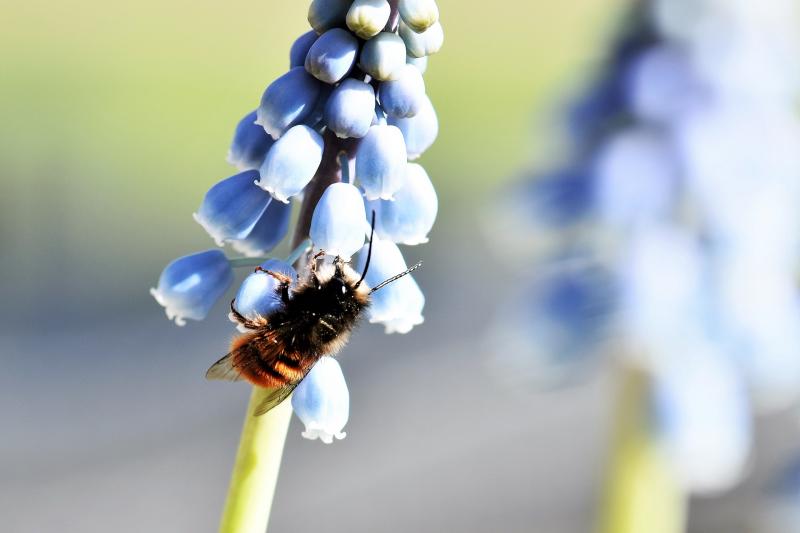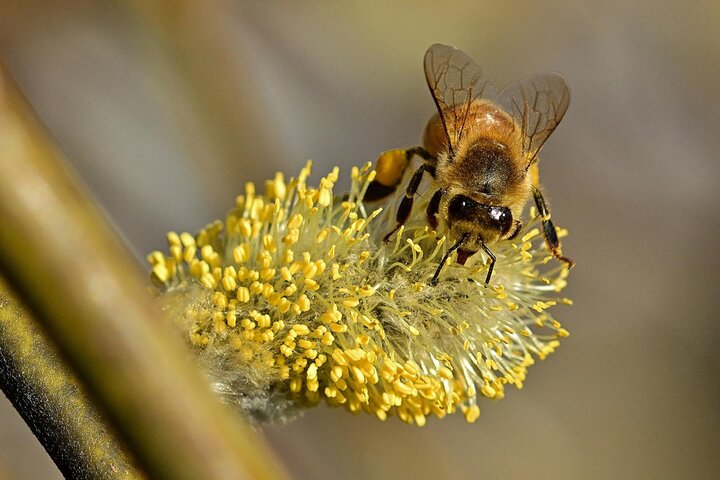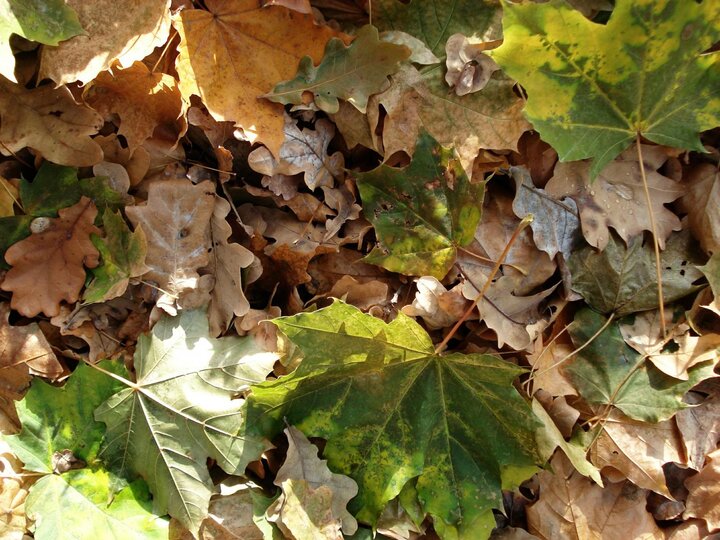
Early spring mason bee feeding on grape hyacinth flowers. Pixabay.com
Spring fever is upon us! These warm, sunny days are just so wonderful, it makes any gardener want to get out in their garden and landscape. But with concerns about bees, other pollinators and beneficial insects at the forefront of many gardener’s minds, it’s important to understand what you can do now – before you clean up the spring garden – to maintain and create good insect habitat. Insects over winter in a variety of ways, but these can be broadly grouped as 1) protected in the soil, 2) within leaf litter or other vegetation and 3) above ground on vegetation or other surfaces.
In years past, many gardeners cleaned up all the debris in their gardens, making them clean as a whistle to start the growing season. This often involved cutting down stems from perennials to the ground or as close to the plant crown as possible. Removing any leaves that blew into the garden over winter and any dead leaves from last year’s growth.
But we know some of those dead stems may have overwintering insects inside such as stem-nesting bees. Plus, there are many beneficial insects overwintering in leaf litter or just under the soil surface, so cutting down and discarding all of last year’s stems and leaves can reduce the number of beneficial insects in your garden.
Mary Gardiner, Ohio State University Assistant Professor of Entomology and author of Good Garden Bugs, notes that many insects overwintering in the soil begin to emerge when soil temperatures reach 45-50°F.
But unless you are actively tilling the soil in spring (which we would not recommend) it’s unlikely your work in the garden will damage soil-nesting bees if you begin work before the soil reaches these temperatures. But just to be safe, you could consider waiting to begin your garden clean-up until your grass is actively growing and needing regular mowing or plum and pear trees are blooming. By that time, many bees will have emerged to take advantage of the spring flowers.
Here are some things you can do to get your gardens ready for another growing season, while preserving good habitat for bees, pollinators and beneficial insects.

Don’t be a Neat Freak
Consider allowing your gardens to have a slightly more natural, unmanicured look. Getting rid of all that leaf debris is not only a waste of good organic material, it decreases your population of beneficial insects.
For example, luna moths lay eggs on a variety of trees, including black walnut, willow, sumac and white birch. They overwinter as cocoons, which can often be found beneath these trees and could be discarded or killed during spring garden clean-up. Praying mantids overwinter as eggs in a dried papery egg mass on plant stems. Fireflies, lady bugs, spider mite destroyers, ground beetles and many other beneficial insects hide in protected leaf litter during winter.
A thick mulch layer is difficult for ground-nesting bees to dig through to reach the soil beneath; this reduces the potential for these bee species to make their home in your landscape. Leaf litter is easier for them to dig through, so creates better habitat.
Consider using existing leaf litter as your mulch or only mulching a few feet at the front of your gardens in the most visible areas. Allow the back of beds, which are less visible, to remain covered by a natural mulch of leaf and plant debris.

Cut Down Stems – Part Way
Many gardeners know leaving dead flower stalks standing overwinter, is a good practice. Instead of cutting them back to the ground in spring, cut back to staggered heights ranging from 8-24 inches. Allowing the stem bases to stand, will protect any overwinter insects inside until they emerge. The hollow stems will also be used by more insects this fall as overwintering sites.
The stems many also provide some support for your perennials this summer, helping those that tend to flop down stand a little taller. Your plant’s new growth will quickly cover and hide these old stems from view. The infographic below, from The Ohio State University, gives a good overview of how to maintain garden perennials while maintaining good bee habitat.
How to Create Habitat for Stem-nesting Bees.
In my garden, once I’ve cut my perennial stems back to staggered height, I then cut the old stem tops I have removed into smaller pieces(about 4-6 inches)and allow them to lay on the ground, utilizing them as leaf litter as discussed above. They contribute organic matter to the garden as they decay and any remaining seeds in the old flower heads may start new plants.
If the garden doesn’t look neat enough when you’re done, lightly top dress with mulch. This will hold any leaves or debris in place, reducing the potential of it blowing out of your beds. Just don’t put it on too thickly if you’re trying to maximize habitat for ground-nesting bees.
When you’re done, you’ll have neat looking gardens ready for spring growth, healthy plants and great habitat for bees, pollinators and other beneficial insects.
Images
- Early spring mason bee feeding on grape hyacinth flowers. Pixabay.com
- Early blooming trees and shrubs like pussy willow are an early spring food source for bees. Pixabay.com
- Leaf litter provides the natural benefits of mulch in landscape beds and increase habitat quality for soil-nesting bees PIxabay.com